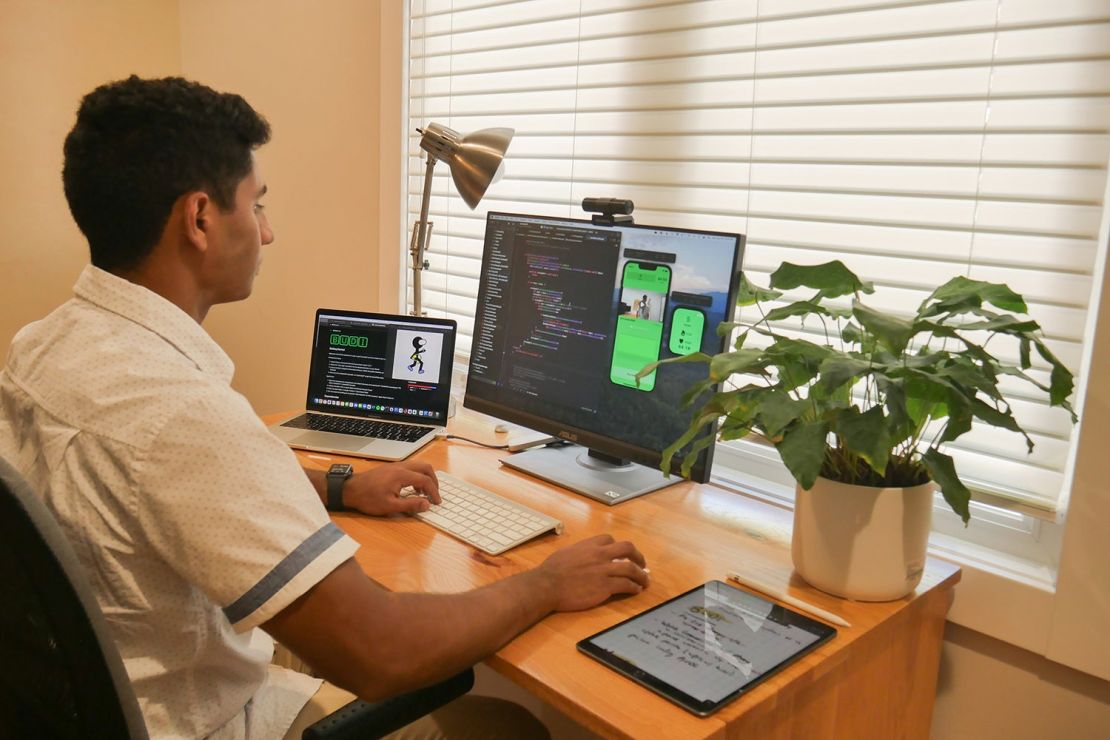Medical student Blynn Shideler arrived at Stanford with an award-winning health device – and every intention of improving it.

From left to right, Maria Shcherbakova, Blynn Shideler (wearing the original “bulky bracelet” prototype), and Taylor Lallas at the Stanford Byers Center for Biodesign. (Image credit: Courtesy Blynn Shideler)
The device addresses a need in the cerebral palsy community. Often, kids with cerebral palsy – a group of disorders that affect movement, balance, and posture – need daily sessions with a physical therapist to build strength and improve motor skills. As an undergraduate studying bioengineering at Columbia University, Shideler thought there must be a better way.
He collaborated with other students to design a device that would make it easier for these kids to perform their therapy exercises at home, or anywhere. The result was BUDI – the Biofeedback Upper-limb Device for Impairment – a bulky bracelet built with sensors that tracked motion and provided feedback on how the user might want to adjust how they are moving.
BUDI was named “Most Outstanding Design Project from Columbia Biomedical Engineering,” and Columbia shared the news on social media. People in the cerebral palsy community noticed.
“A teenager in Ohio reached out and said, ‘I have CP, saw your product and would love to try it,’ ” Shideler said.
But Shideler had no bracelets to give. His team had only built two prototypes. So, inspired by that message from someone he didn’t know living across the country, Shideler set out to produce BUDI on a larger scale.
Creating solutions that scale
In the fall of 2021, Shideler enrolled in Stanford School of Medicine and planned to start a program that would give children with cerebral palsy the opportunity to try technologies for improving mobility. He received a grant from the FDA’s Pediatric Device Consortium to develop wearable devices and assistive technologies for pediatric rehabilitation.
Shideler also attended an introductory session for CardinalKit, an open-sourced platform designed by Stanford researchers for coding digital health research projects.
“I learned about building an iOS app and what you can do with the available sensors on Apple watches and iPhones,” he said. “It really started to click; maybe BUDI could be designed as software on a commercially-available smartwatch rather than building bracelets and shipping them to people.”
If BUDI were available in the app store, Shideler thought, kids anywhere could have physical therapy on demand on their wrists. It would give them some autonomy, help alleviate problems created by a shortage in physical therapists, and reduce the strain on families who currently take their kids to therapy every day.
Building a team
Oliver Aalami, a clinical professor of vascular surgery, hosted the Intro to CardinalKit session and suggested Shideler enroll in Biodesign for Digital Health, a course Aalami teaches. In class, students work in teams of three to identify an unmet need in healthcare that can be addressed with digital solutions. The teams research and evaluate needs, brainstorm solutions, and learn to assess their ideas.

Ohio State University biomedical engineering student Mihir Joshi writing code for BUDI. (Image credit: Courtesy Blynn Shideler)
Going into that course, Shideler had already interviewed children with cerebral palsy and was able to narrow his proposed solution to technology that focused on upper body strength and dexterity because most of the available therapy focused on walking and lower-body strength. It was natural, then, for Shideler to serve as a mentor the next quarter for Building for Digital Health, a follow-up course where students prototype their designs from Biodesign for Digital Health.
To build out BUDI, Shideler worked with Stanford computer science student Taylor Lallas, Stanford graduate Maria Shcherbakova, and Ohio State biomedical engineering student Mihir Joshi.
The team worked with four faculty advisors: Scott Delp, a professor of bioengineering and of mechanical engineering; Jennifer O’Malley, a clinical assistant professor of neurology, whose research focuses on children with movement disorders; Emily Kraus, a clinical assistant professor of orthopaedic surgery at Stanford Children’s Orthopedic and Sports Medicine Center; and Vishnu Ravi, MD, the lead architect of the CardinalKit project.
BUDI: A new pal for therapy
The first version of the BUDI application is a platform where users can follow along with therapeutic exercises on an iPhone while motion data from a user’s Apple Watch is sent to the iPhone in real-time to provide biofeedback, creating an interactive mobility training program. User data is stored in HIPAA-compliant security on Google Cloud and fully integrated into Apple Fitness to track therapy in Apple Health and see progress over time.
“Regular participation in high-quality therapy services is essential to maximizing function for children with cerebral palsy,” O’Malley said. “Equitable access (geographically, financially, socially) to such services is a major barrier for many children. Blynn’s device employs easy-to-use technology to bring a novel approach to therapy that also begins to address the problem of accessibility and equity for children in need.”
BUDI also fosters communications between therapy providers and their patients, which enables pediatric users to gain autonomy in their own therapy.
“A single device utilizing modern technology while also combating gaps in equity and accessibility AND promoting user autonomy is an exciting and very welcome innovation!” O’Malley said.
And the first beta-tester – the Ohio native who requested the original bulky bracelet – is ready and waiting.
“He’s met with our team several times to offer feedback and even came to the presentation for our final class of Biodesign,” Shideler said. “We are all very excited to give him the application. It’s come a long way since the first bracelet. We hope that many people with cerebral palsy, or really anybody who wants to improve flexibility and mobility, will try it out and tell us ways we could improve.”
To read all stories about Stanford science, subscribe to the biweekly Stanford Science Digest.